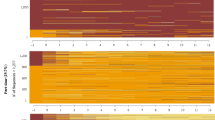Abstract
To explore single mothers’ labor market participation we analyzed specific circumstances and dynamics in their life courses. We focused on the question which individual and institutional factors determine both professional advancement and professional descent. The German Socio-Economic Panel (1984–2010) provides all necessary information identifying episodes of single motherhood and analyzing restrictions and interruptions of employment during life courses. Since family statuses of single mothers are partially endogenous and can end in multiple ways, we used semi-parametric survival models. Competing risks estimations showed that occupational careers of single mothers are influenced by individual factors such as appointed and reliable working hours, and further by the institutional determinants childcare or welfare benefits.

Similar content being viewed by others
Notes
Numbers of cases in the estimates differ from the number of episodes mentioned before because transition into different employment states can only be observed for individuals in specific subgroups. Results for testing the proportional hazard assumption can be found in the appendix.
References
Andreß, H.-J., Borgloh, B., Bröckel, M., Giesselman, M., & Hummelsheim, D. (2006). The economic consequences of partnership dissolution—a comparative analysis of panel studies from Belgium, Germany, Great Britain, Italy, and Sweden. European Sociological Review, 22, 533–560. doi:10.1093/esr/jcl012.
Becker, G. S. (1965). A theory of the allocation of time. Economic Journal, 75(299), 493–517. http://www.jstor.org/stable/2228949.
Blau, D. M., & Tekin, E. (2007). The determinants and consequences of child care subsidies for single mothers. Journal of Population Economics, 20(4), 719–741. doi:10.1007/s00148-005-0022-2.
Blossfeld, H.-P. (1995). The new role of women: Family formation in modern societies. Boulder: Westview.
Blossfeld, H.-P., & Rohwer, G. (2001). Techniques of event history modeling. Mahwah: Erlbaum.
BMFSFJ (2008).Alleinerziehende: Lebens- und arbeitssituation sowie lebenspläne, Berlin.
Boss, A., Christensen, B.,& Schrader, K. (2010). Die Hartz IV-Falle: Wenn Arbeit nicht mehr lohnt.Kieler Diskussionsbeiträge, 474, 475.
Cascio, E. U. (2009). Maternal labor supply and the introduction of kindergartens into American public schools. The Journal of Human Resources, 44(1), 140–170. doi:10.3368/jhr.44.1.140.
Cleves, M. A., Gould, W. W., & Gutierrez, R. G. (2004). An introduction to survival analysis using STATA. College Station: Stata.
Cox, D.R. (1972). Regression models and life tables. Journal of the Royal Statistic Society (Series B Methodological), 34, 187–220. http://www.jstor.org/stable/2985181.
Drobnič, S. (2000). The effects of children on married and lone mothers’ employment in the United States and (West) Germany. European Sociological Review, 16(2), 137–157. doi:10.1093/esr/16.2.137.
Edin, K., & Lein, L. (1997). Work, welfare, and single mothers’ economic survival strategies. American Sociological Review 62(2), 253–266. http://www.jstor.org/stable/2657303.
Francesconi, M., & Van der Klaauw, W. (2007). The socioeconomic Consequences of ‘in-work’ benefit reform for British lone mothers. The Journal of Human Resources, 42(1), 1–31. doi:10.3368/jhr.XLII.1.
Geisler, E., & Kreyenfeld, M. (2005).Müttererwerbstätigkeit in Ost- und Westdeutschland. Eine Analyse mit den Mikrozensen 1991–2002. MPIDR Working Paper WP 2005/033.
Giddings, L., Dingeldey, I., & Ulbricht, S. (2004). The commodification of lone mothers’ labor: A comparison of US and German policies. Feminist Economics, 10(2), 115–142. doi:10.1080/1354570042000217748.
Golden, L. (2008). Limited access: Disparities in flexible work schedules and work-at-home. Journal of Family and Economic Issues, 29, 86–109. doi:10.1007/s10834-012-9332-1.
Hank, K., & Kreyenfeld, M. (2000). Does the availability of child care influence the employment of mothers? Findings from western Germany. Population Research and Policy Review, 19(4), 317–337. doi:10.1023/A:1026556309080.
Kanji, S. (2011). Labor force participation, regional location, and economic well-being of single mothers in Russia. Journal of Family and Economic Issues, 32, 62–72. doi:10.1007/s10834-010-9198-z.
Kornstadt, T., & Thoresen, T. O. (2007). A discrete choice model for labor supply and childcare. Journal of Population Economics, 20, 781–803. doi:10.1007/s00148-005-0025-z.
Leininger, L. J., & Ziol-Guest, K. M. (2008). Reexamining the effects of family structure on children’s access to care: The single-father family. Health Services Research, 43(1), 117–133. doi:10.1111/j.1475-6773.2007.00758.x.
Lietzmann, T. (2009). Bedarfsgemeinschaften im SGB II: Warum Alleinerziehende es besonders schwer haben. IAB-Kurzbericht, 12, 1–8.
Minotte, K. L. (2012). Family structure, gender, and the work-family interface: Work-to-family conflict among single and partnered parents. Journal of Family and Economic Issues, 33, 95–107. doi:10.1007/s10834-011-9261-4.
Moffitt, R., & Roff, J. (2000). Welfare, children and family: A three city study. (Policy Brief 00–2). Baltimore: John Hopkins University.
Son, S., & Bauer, J. W. (2010). Employed rural, low-income, single mothers’ family and work over time. Journal of Family and Economic Issues, 31, 107–120. doi:10.1007/s10834-009-9173-8.
Sørensen, A. (1994). Women’s economic risk and the economic position of single mothers. European Sociological Review, 10, 173–188. http://www.jstor.org/stable/522307.
Statistische Ämter des Bundes und der Länder (2011) Kindertagesbetreuung regional 2010, Wiesbaden.
Therneau, T. M., & Grambsch, P. M. (2000). Modeling survival data: Extending the Cox Model. New York: Springer.
Urban, J., & Olson, P. (2005). A comprehensive employment model for low-income mothers. Journal of Family and Economic Issues, 26, 101–122. doi:10.1007/s10834-004-1414-2.
Vandecasteele, L. (2011). Life course risks or cumulative disadvantage? The structuring effect of social stratification determinants and life course events on poverty transitions in Europe. European Sociological Review, 27(2), 246–263. doi:10.1093/esr/jcq005.
Van Gameren, E. (2012). The role of economic incentives and attitudes in participation and childcare decisions. Journal of Family and Economic Issues. doi:10.1007/s10834-012-9332-1.
Vogel, C. (2009). Teilzeitbeschäftigung—Ausmaß und Bestimmungsgründe der Erwerbsübergänge von Frauen. Zeitschrift für Arbeitsmarktforschung, 42(2), 170–181. doi:10.1007/s12651-009-0015-9.
Wagenhals, G., Laisney, F., Lechner, M., & Staat, M. (1999). Work and welfare of single mothers in Germany. Revue de l’Institut d’Économie Publique, 1, 111–144.
Wagner, G., Frick, J., & Schupp, J. (2007). The German Socio-Economic Panel Study (SOEP)–Scope. Evolution and Enhancements. Schmollers Jahrbuch, 127(1), 139–169.
Author information
Authors and Affiliations
Corresponding author
Rights and permissions
About this article
Cite this article
Hancioglu, M., Hartmann, B. What Makes Single Mothers Expand or Reduce Employment?. J Fam Econ Iss 35, 27–39 (2014). https://doi.org/10.1007/s10834-013-9355-2
Published:
Issue Date:
DOI: https://doi.org/10.1007/s10834-013-9355-2




